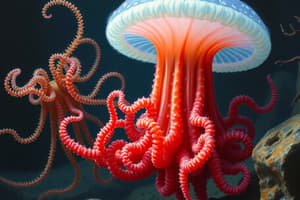Podcast
Questions and Answers
What are the primary functions of cnidoblasts in cnidarians?
What are the primary functions of cnidoblasts in cnidarians?
- Locomotion and waste elimination
- Anchorage, defense, and prey capture (correct)
- Reproduction and nutrient absorption
- Photosynthesis and respiration
Which of the following statements about cnidarians is true?
Which of the following statements about cnidarians is true?
- They exclusively reproduce sexually.
- They are triploblastic and exhibit organ-level organization.
- They have a central gastro-vascular cavity with two openings.
- They have a tissue level of organization and are diploblastic. (correct)
In which cnidarian body form is the organism typically free-swimming?
In which cnidarian body form is the organism typically free-swimming?
- Sponge
- Larvae
- Polyp
- Medusa (correct)
What type of reproduction do polyps undergo to produce medusae?
What type of reproduction do polyps undergo to produce medusae?
What is the skeletal composition of some cnidarians such as corals?
What is the skeletal composition of some cnidarians such as corals?
Which organism is an example of a cnidarian that exhibits both polyp and medusa forms?
Which organism is an example of a cnidarian that exhibits both polyp and medusa forms?
Study Notes
Cnidarians Overview
- Cnidoblasts or cnidocytes contain stinging capsules known as nematocysts, found on tentacles and body surfaces.
- Cnidoblasts are utilized for multiple purposes: anchorage, defense, and prey capture.
- Cnidarians exhibit a tissue level organization and are classified as diploblastic, meaning they have two tissue layers.
- The central gastro-vascular cavity features a single opening, functioning as both mouth and anus, located on the hypostome.
Digestion and Skeletal Structures
- Digestion in cnidarians occurs both extracellularly and intracellularly.
- Some cnidarians, such as corals, possess a hard skeleton made of calcium carbonate.
Body Forms
- Cnidarians display two primary body forms:
- Polyp: A sessile, cylindrical form (e.g., Hydra, Adamsia).
- Medusa: An umbrella-shaped, free-swimming form (e.g., Aurelia, jellyfish).
Alternation of Generations
- Cnidarians that exhibit both body forms undergo alternation of generations (Metagenesis).
- Polyps asexually produce medusae, while medusae sexually reproduce to form polyps (e.g., Obelia).
Examples of Cnidarians
- Notable examples include:
- Physalia: Portuguese man-of-war
- Adamsia: Sea anemone
- Pennatula: Sea-pen
- Gorgonia: Sea-fan
- Meandrina: Brain coral
Other Related Organisms
- Examples of sponges, which are part of a different phylum, include:
- Sycon: Scypha
- Spongilla: Freshwater sponge
- Euspongia: Bath sponge
Studying That Suits You
Use AI to generate personalized quizzes and flashcards to suit your learning preferences.
Description
Explore the fascinating world of cnidarians, including their unique structures, body forms, and digestive processes. This quiz covers essential concepts such as cnidoblasts, alternation of generations, and skeletal structures like those found in corals. Test your knowledge on these important marine organisms!




